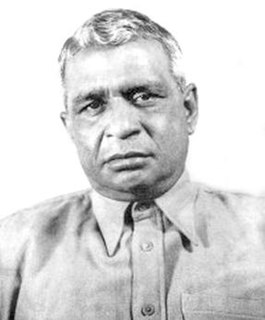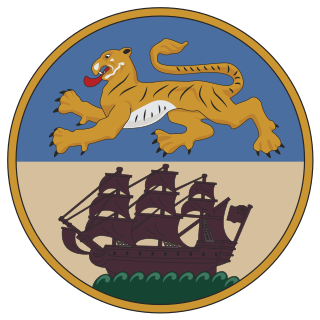Related Research Articles

Huseyn Shaheed Suhrawardy was a Bengali Pakistani barrister and politician. He served as the Prime Minister of Pakistan from 1956 to 1957 and before that as the Prime Minister of Bengal from 1946 to 1947 in British Raj. In Pakistan, Suhrawardy is revered as one of the country's founding statesmen. In Bangladesh, Suhrawardy is remembered as the mentor of Bangladesh's founding leader Sheikh Mujibur Rahman. In India, he is seen as a controversial figure; some hold him responsible for the 1946 Calcutta Killings, for which he is often referred as the "Butcher of Bengal” in West Bengal. In India he is also remembered for his performance as the Minister for Civil Supply during the Bengal famine of 1943.

The 1947 Indian Independence Act [1947 c. 30 ] is an Act of the Parliament of the United Kingdom that partitioned British India into the two new independent dominions of India and Pakistan. The Act received Royal Assent on 18 July 1947 and thus modern day India and Pakistan, comprising west and east regions, came into being on 15 August.

The Constituent Assembly of India was elected to frame the Constitution of India. It was elected by the 'Provincial Assembly'. Following India's independence from the British rule in 1947, its members served as the nation's first Parliament as the 'Provisional Parliament of India'.

Abul Kasem Fazlul Huq, popularly known as Sher-e-Bangla, was a British Indian and Pakistani lawyer, writer who presented the Lahore Resolution that aimed the creation of Pakistan. He also served as the first and longest Prime Minister of Bengal in British Raj before that he served as the Mayor of Calcutta. After independence, he held various senior offices such as the Interior Minister of Pakistan, Governor of East Pakistan and Chief Minister of East Bengal.

The Partition of Bengal in 1947, part of the Partition of India, divided the British Indian province of Bengal based on the Radcliffe Line between the Dominion of India and the Dominion of Pakistan. The Hindu-majority West Bengal became a state of India, and the Muslim-majority East Bengal became a province of Pakistan.

The Dominion of India, officially the Union of India, was an independent dominion in the British Commonwealth of Nations existing between 15 August 1947 and 26 January 1950. Until its independence, India had been ruled as an informal empire by the United Kingdom. The empire, also called the British Raj and sometimes the British Indian Empire, consisted of regions, collectively called British India, that were directly administered by the British government, and regions, called the princely states, that were ruled by Indian rulers under a system of paramountcy. The Dominion of India was formalised by the passage of the Indian Independence Act 1947, which also formalised an independent Dominion of Pakistan—comprising the regions of British India that are today Pakistan and Bangladesh. The Dominion of India remained "India" in common parlance but was geographically reduced. Under the Act, the British government relinquished all responsibility for administering its former territories. The government also revoked its treaty rights with the rulers of the princely states and advised them to join in a political union with India or Pakistan. Accordingly, the British monarch's regnal title, "Emperor of India," was abandoned.

East Bengal was a geographically noncontiguous province of the Dominion of Pakistan covering present-day Bangladesh. With its coastline on the Bay of Bengal, it bordered India and Burma. It was located close to, but did not share a border with, Nepal, Tibet, the Kingdom of Bhutan and the Kingdom of Sikkim. It’s capital was Dacca, now known as Dhaka.

The East Pakistan Provincial Assembly, known as the East Bengal Legislative Assembly between 1947 and 1955, was the provincial legislature of East Pakistan between 1947 and 1971. It was known as the East Bengal Assembly from 1947 to 1955 when the provincial name was changed. The legislature was a successor to the Bengal Legislative Council and the Bengal Legislative Assembly, which were divided between East Bengal and West Bengal during the partition of Bengal in 1947. It was the largest provincial legislature in Pakistan. Elections were held only twice in 1954 and 1970.

Dhirendranath Datta was a Bengali lawyer by profession who was also active in the politics of undivided Bengal in pre-partition India, and later in East Pakistan (1947–1971).

Jogendranath Mandal , was one of the founding fathers of modern state of Pakistan, and legislator serving as country's first minister of law and labour, and also was second minister of Commonwealth and Kashmir affairs. In the cabinet of Interim Government of India, He got the law portfolio before. As a leader of the Scheduled Castes (Dalits), Jogendranath Mandal campaigned against the division of Bengal in 1947, believing that the divided Bengal would mean that Dalits would be at the mercy of the Muslim majority in East Bengal (Pakistan), and at the thraldom of majority caste-Hindus in West Bengal (India). In the end, he decided to maintain his base in East Pakistan, hoping that the Dalits would be benefited from it and joined the first cabinet in Pakistan as the Minister of Law and Labour. He migrated to India a few years after partition after submitting his resignation to Liaquat Ali Khan, the then Prime Minister of Pakistan, citing the anti-Dalits bias of Pakistani administration.

The West Bengal Legislative Assembly is the unicameral legislature of the Indian state of West Bengal. It is located in the B. B. D. Bagh area of Kolkata (Calcutta)-the Capital of the state. Members of the Legislative assembly are directly elected by the people. The legislative assembly comprises 294 Members of Legislative Assembly, all directly elected from single-seat constituencies. Its term is five years, unless sooner dissolved.

United Bengal was a proposal to transform Bengal Province into an undivided, sovereign state at the time of the Partition of India in 1947. It sought to prevent the division of Bengal on religious grounds. The proposed state was to be called the Free State of Bengal. A confessionalist political system was mooted. The proposal was not put up for a vote. The British government proceeded to partition Bengal in accordance with the Mountbatten Plan and Radcliffe Line.
The Constitution of 1956 was the fundamental law of Pakistan from March 1956 until the 1958 Pakistani coup d'état. It was the first constitution adopted by independent Pakistan. There were 234 articles 13 parts and 6 schedules.

After power transformation, on 15 August 1947, Jawaharlal Nehru assumed office as the first Prime Minister of India and chose fifteen ministers to form the First Nehru ministry.

The Government of East Pakistan or formerly Government of East Bengal governed the province East Bengal and was centered in its provincial capital Dhaka. The head of the province was the Governor, who was nominated by the President of Pakistan. While the head of the province of East Pakistan was the Chief Minister who was elected by the East Pakistan Assembly.

The Legislatures of British India included legislative bodies in the presidencies and provinces of British India, the Imperial Legislative Council, the Chamber of Princes and the Central Legislative Assembly. The legislatures were created under Acts of Parliament of the United Kingdom. Initially serving as small advisory councils, the legislatures evolved into partially elected bodies, but were never elected through suffrage. Provincial legislatures saw boycotts during the period of dyarchy between 1919 and 1935. After reforms and elections in 1937, the largest parties in provincial legislatures formed governments headed by a prime minister. A few British Indian subjects were elected to the Parliament of the United Kingdom, which had superior powers than colonial legislatures. British Indian legislatures did not include Burma's legislative assembly after 1937, the State Council of Ceylon nor the legislative bodies of princely states.

The Bengal Legislative Assembly was the largest legislature in British India, serving as the lower chamber of the legislature of Bengal. It was established under the Government of India Act 1935. The assembly played an important role in the final decade of undivided Bengal. The Leader of the House was the Prime Minister of Bengal. The assembly's lifespan covered the anti-feudal movement of the Krishak Praja Party, the period of World War II, the Lahore Resolution, the Quit India movement, suggestions for a United Bengal and the partition of Bengal and partition of British India.
Siris Chandra Chattopadhyaya was a Bengali civil servant and politician from East Bengal. He was a Member of the 1st National Assembly of Pakistan as a representative of East Pakistan. He was born in Dhaka.
Muhammad Abdullah al-Baqi was a Bengali Islamic scholar, writer and politician. As a member of the Central Legislative Assembly, he played an active role in the Indian independence movement. He was a prominent leader of the Ahl-i Hadith movement in North Bengal, and played a significant roles in pre-partition Ahl-i Hadith conferences.
Abdul Matin Chaudhary, also known by his daak naam Kola Mia, and the epithet Jinnar Daan Haat, was a Pakistani Bengali politician, journalist and a member of the 1st National Assembly of Pakistan as a representative of East Bengal. He was also Pakistan's inaugural Minister of Agriculture.
References
- ↑ "List of members of the 2nd National Assembly of Pakistan" (PDF). na.gov.pk. Retrieved 12 November 2021.
- 1 2 Legislature, Pakistan Constituent Assembly (1947-1954) (1952). The Constituent Assembly (Legislature) of Pakistan Debate: Official Report. Manager of Publications. p. 775.